A consensus Approach to Wound Care
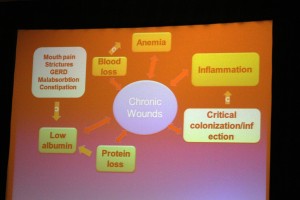 This talk was given by Dr. Elena Pope and it was very interesting. I think what would have helped more-and perhaps this is something I will suggest for future conferences-if it came with a full blown Wound Care 101 with explanation and showing of the different products available. I know I am not only speaking about myself when I say that, even though Nicky is nearly 16 years old, since there are always new products out there which we are unsure how to use, a hands-on explanation with samples given to try would have been extremely helpful. Just me?
This talk was given by Dr. Elena Pope and it was very interesting. I think what would have helped more-and perhaps this is something I will suggest for future conferences-if it came with a full blown Wound Care 101 with explanation and showing of the different products available. I know I am not only speaking about myself when I say that, even though Nicky is nearly 16 years old, since there are always new products out there which we are unsure how to use, a hands-on explanation with samples given to try would have been extremely helpful. Just me?
 Anyhoo…the presentation started with an explanation of chronic wounds and how to care for them. How important Hemoglobin levels are to keep the healing ongoing, which is why iron supplements and infusions are so important.
Anyhoo…the presentation started with an explanation of chronic wounds and how to care for them. How important Hemoglobin levels are to keep the healing ongoing, which is why iron supplements and infusions are so important.
Chronic Wounds are like a vicious cycle and once you get one it’s hard to get rid of it because it basically feeds on itself. Ugh. Another thing to keep into consideration is if the wound edge is even or rocky. Rocky might mean the big C, so she stressed the importance of having it biopsied. Ick. She stated that SCC (Squamous Cell Carcinoma), which is usually sun induced, with RDEB and the wounds constantly trying to heal, it starts in there, making it more aggressive as it would otherwise be. The absence of collagen VII makes it more aggressive than usual because it’s the collagen that fights the cancer to begin with.
 The most important slide that you will ever see is this one on the right. Click on it to see it bigger and print it! That’s what I did. It goes on detail of what you should use on what type of wound. For example… what to put on just for protection or if it’s an itchy wound or an infected wound or a painful wound. I would have liked if it came with names of products in detail with choices, such as… Mepitel is better than Xeroform on this type of wound and that sort of thing, but overall I think it’s very helpful!!
The most important slide that you will ever see is this one on the right. Click on it to see it bigger and print it! That’s what I did. It goes on detail of what you should use on what type of wound. For example… what to put on just for protection or if it’s an itchy wound or an infected wound or a painful wound. I would have liked if it came with names of products in detail with choices, such as… Mepitel is better than Xeroform on this type of wound and that sort of thing, but overall I think it’s very helpful!!
Here is the video of this presentation, courtesy of Debra of America:
Cell Therapy for EB
 This talk was given by Dr. Alfred Lane-this is the second talk that I was very excited to hear. Unlike the Protein Therapy, which would need to be infused into the patient every 4-6 weeks to keep the disorder at bay, this is a genetically modified skin graft which would permanently heal whatever area it’s put on. It involves Gene Transfer, which is inserting the correct gene into the DNA structure using a virus, and it starts working right away.
This talk was given by Dr. Alfred Lane-this is the second talk that I was very excited to hear. Unlike the Protein Therapy, which would need to be infused into the patient every 4-6 weeks to keep the disorder at bay, this is a genetically modified skin graft which would permanently heal whatever area it’s put on. It involves Gene Transfer, which is inserting the correct gene into the DNA structure using a virus, and it starts working right away.
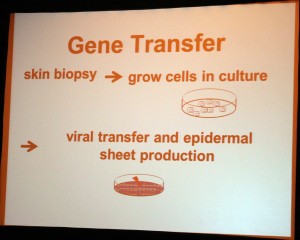 Only 5% of DNA makes protein, so the risk is minimal. It would involve a skin biopsy, growing cells in vitro, viral transfer to genetically cure the faulty gene and the making of skin to staple to the wound (skin graft). This would last the life of the individual. That area is CURED! No more blisters!
Only 5% of DNA makes protein, so the risk is minimal. It would involve a skin biopsy, growing cells in vitro, viral transfer to genetically cure the faulty gene and the making of skin to staple to the wound (skin graft). This would last the life of the individual. That area is CURED! No more blisters!
The biggest obstacle in doing this for years and years was to get FDA approval but that obstacle is now surmounted. Several years ago they tried this method on an Italian patient in Turin and it worked, he no longer blistered in that area.
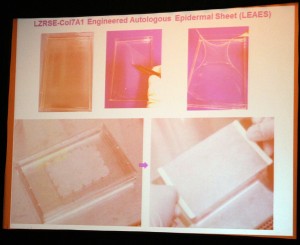
I actually spoke to this patient on the phone once and told me the details and he was very excited!
They have been trying to get the trials started for a while now (a couple of years at least) but now Dr. Lane stated that they should be starting the first subject this year. FDA rules require patients to be at least 18 years old to give their full consent, but after they have 5 successful subjects trials, they can re-evaluate and the FDA will most likely approve patients between 7-17, the patient still has to understand and give their consent, that’s why he/she has to be older than 7.
Dr. Lane explained how this is truly a long term solution and they had never a single problem or side effect with the mice they worked with and there are no unnecessary risks to patients. Other skin disorder advocates and researchers are keeping a close eye on this particular research because if it’s a success, it will help hundreds of thousands of other patients suffering from not only other forms of EB but also one of the other 300 skin disorders out there.
 When asked ‘when’ the trial will be over and this will become available to everyone, Dr. Lane had a hard time being specific. He wanted it to be done yesterday, a year ago, 5 years ago. If you would have asked him 10 years ago, he would have said a couple of years. It’s hard to say. It’s hard to predict when obstacle will come to delay the process.
When asked ‘when’ the trial will be over and this will become available to everyone, Dr. Lane had a hard time being specific. He wanted it to be done yesterday, a year ago, 5 years ago. If you would have asked him 10 years ago, he would have said a couple of years. It’s hard to say. It’s hard to predict when obstacle will come to delay the process.
I remember adding in my mind the 5 patients and how long each patient will be in the trial, so if everything went extremely well, maybe a couple of years?  Who knows.
Who knows.
For more information about this study, please go to THIS LINK.
They are now recruiting patients for the trial, please contact Emily Gorell, to find out more about study enrollment and requirements.
She may be reached at (650) 721-7166 or egorell@stanford.edu.
Here is the video of this presentation, courtesy of Debra of America:
Management of Esophageal Strictures in EB Patients
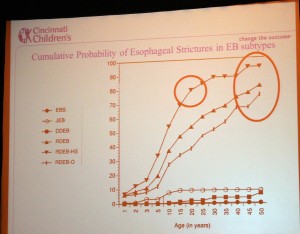 This talk was given by Dr. Richard Azizkhan. An Esophageal Stricture is a scar or narrowing of the esophagus that can make swallowing solids or even liquids difficult. The scar involves the lining of the esophagus, not the muscle.
This talk was given by Dr. Richard Azizkhan. An Esophageal Stricture is a scar or narrowing of the esophagus that can make swallowing solids or even liquids difficult. The scar involves the lining of the esophagus, not the muscle.
This slide shows the probability of it depending on the EB subtype. I must admit, I sighed when I saw this. By the time Nicky was 3, he had to have his first, and he was so bad I ended up needing to put a g-tube on him as well at the same time. According to this chart, only 10-15% of RDEB patients need this at this age. Wonderful. Ok, moving on…
 The only technique used these days that works best in fixing this issue is the balloon dilatation. Dr. Castillo at Stanford proudly told me he was the one that came up with this procedure :0). He stated it works well also because it can be repeated multiple times on the same patient without a problem, even dozens of times.
The only technique used these days that works best in fixing this issue is the balloon dilatation. Dr. Castillo at Stanford proudly told me he was the one that came up with this procedure :0). He stated it works well also because it can be repeated multiple times on the same patient without a problem, even dozens of times.
However, as with anything, there are caveats.

The patient cannot have very severe anemia for example. Dr. Azizkhan sadly stated how one of his patients almost died and had to be resuscitated and later went into a coma because they did not know how anemic he was before the procedure. Always make sure the patient is not severely anemic beforehand! Cincinnati now routinely does blood-work beforehand to make sure this never happens again.
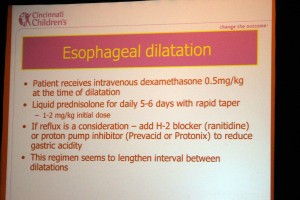 I talked to the mom of this patient… to be honest, I cannot imagine. Not only this child (I believe he is maybe 5 years old?) has rather severe RDEB, he woke up from the coma not exactly like he was before. Because his brain went without oxygen for a time, he has a long road ahead. Neurologists say that because he’s still a child and his brain is still forming there is a lot of hope for him. Please pray for this precious child!!
I talked to the mom of this patient… to be honest, I cannot imagine. Not only this child (I believe he is maybe 5 years old?) has rather severe RDEB, he woke up from the coma not exactly like he was before. Because his brain went without oxygen for a time, he has a long road ahead. Neurologists say that because he’s still a child and his brain is still forming there is a lot of hope for him. Please pray for this precious child!!
These slides give a LOT of good info on how the procedure is done and what the outcome has been over the last 20 years of doing this procedure. Please click on the image to open a bigger version.
OK, part of this talk also included gastronomy tubes, or g-tubes for short and indications. The most important indication is growth failure. As I stated in a previous blog, not ‘just’ for weight issues, but growth failure indicates also failure in stature and head circumference. 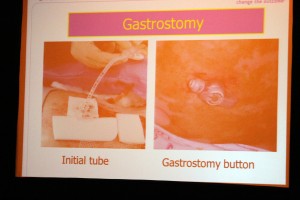 It’s also a safety net for those that require constant, multiple throat dilatations and also to address behavioral issues and family dynamics. It becomes a must for about 40-50% of RDEB patients and also many newborns with feeding issues of all other forms of EB.
It’s also a safety net for those that require constant, multiple throat dilatations and also to address behavioral issues and family dynamics. It becomes a must for about 40-50% of RDEB patients and also many newborns with feeding issues of all other forms of EB.
The patient is initially given a temporary tube and several weeks later a permanent tube, most commonly a mic-key is put in place.
Here is the video of this presentation, courtesy of Debra of America:
Below is a video from the 2010 conference about Dilatations and G-tubes.
Ocular Surface Rehabilitation in Dystrophic EB
This talk was given by Dr. Arturo Kantor, who had quite an array of interesting information. Before his talk the only issue with the eyes I ever heard of or experienced are corneal abrasions, which Nicky is, of course, not a stranger to. However, he related that some patient have SEVERE eye involvement, and those that do, usually have Dystrophic EB and also have esophageal involvement. Some patients with Junctional have these problems as well, but he stated this is not a problem that Simplex patients have at all.
 His suggestions were to use Preservative Free Lubricants and Bandage Contact Lenses. CL do not prevent erosions, but new epithelium grows underneath and helps the eye.
His suggestions were to use Preservative Free Lubricants and Bandage Contact Lenses. CL do not prevent erosions, but new epithelium grows underneath and helps the eye.
The contact lenses he suggests are not available over the counter, and must be High DK over 120, highly permeable. He also suggests GenTeal Gel for eyes.
The doctor also showed some videos of a patient he had to replace the cornea of… highly graphic videos that I squirm just thinking about, so I will spare the one photo I took of because it reminds me of them, ha ha.
Here is the video of this presentation, courtesy of Debra of America:
Insurance Advocacy
This talk was given by Michelle Graham was the FINAL presentation of the conference!! She started with an explanation of the various HMO, PPO, POS, EPO and also Medicare, Medicaid and CHIP.
A good website to look at, with detailed information about all the different programs that may be available in your state is: http://insurekidsnow.gov/
She also discussed how fully vested insurance plans are much better and offer a lot more coverage than self funded employer plans. She stated it’s important to make a list of things needed, such as bandages, doctors, medications before switching plans, review the list with your HR or broker and request a written letter to validate what was told to you. If the new plan is lacking what you need, ask for other plans or if exceptions can be made depending on diagnosis.
If a claim is denied, be pro-active. Call and write your insurance provider, write everything down, know your rights. Call your State Insurance Commissioner with problems.
Here is the video of this presentation, courtesy of Debra of America:
Here is the video from the 2010 Conference!!
Please Note: I tried to post as many videos from the 2010 Conference as they were appropriate in their respective sections. ALL the videos that are available to be watched can be found HERE: http://www.youtube.com/user/ebnursemarketing?feature=watch
The videos from the 2012 Conference are now available and I embedded the link in the respective sections. THANK YOU!!!
Links to — > Part 1 – Part 2 – Part 3 – Part 4 – Part 5 – Part 6 – Part 7








